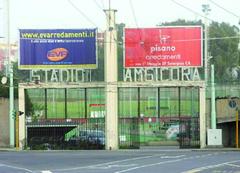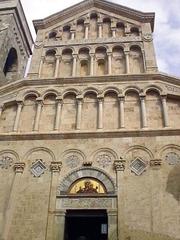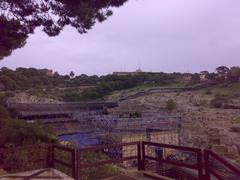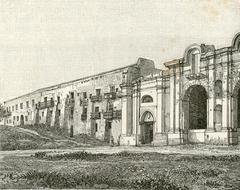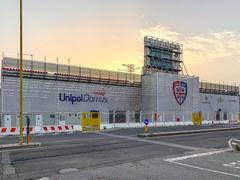
Torre di San Pancrazio: Visiting Hours, Tickets, and Historical Significance in Cagliari
Date: 04/07/2025
Introduction
Rising above the historic Castello district of Cagliari, the Torre di San Pancrazio is an enduring emblem of the city’s medieval past and strategic importance in the Mediterranean. Erected in 1305 during the Pisan rule and masterfully designed by Giovanni Capula, this imposing limestone tower once formed a critical part of Cagliari’s defensive system. Its formidable presence—standing at nearly 37 meters with walls up to three meters thick—speaks to centuries of military innovation, shifting regimes, and evolving civic functions. Today, the Torre di San Pancrazio offers not only a remarkable window into Sardinia’s layered history but also panoramic views of Cagliari and its surroundings, making it a must-visit destination for history enthusiasts, architecture lovers, and curious travelers alike (Sardegna Turismo; Cagliari Turismo; Strictly Sardinia).
Table of Contents
- Introduction
- Medieval Origins and Construction
- Strategic Role in Cagliari’s Defense
- Architectural Features and Modifications
- Historical Events and Symbolism
- Visiting Torre di San Pancrazio: Hours, Tickets & Accessibility
- Travel Tips and Nearby Attractions
- Preservation and Modern-Day Relevance
- Notable Facts and Figures
- Frequently Asked Questions (FAQ)
- Visuals and Media
- Conclusion
- References
Medieval Origins and Construction
The Torre di San Pancrazio was constructed in 1305 as part of a major fortification drive by the Pisan rulers. Renowned architect Giovanni Capula oversaw its design, employing local white limestone quarried from the Bonaria hills to ensure both strength and longevity. This strategic stronghold, together with the Torre dell’Elefante and the now-lost Torre dello Sperone, formed a defensive axis at the northern entrance to Castello—the heart of Cagliari’s civic, military, and religious life at the time (Sardegna Turismo; CagliariMag).
The tower’s design reflects the military priorities of the era: a square plan, walls up to three meters thick on three sides, and a fourth side open toward Castello, with wooden walkways connecting the levels. This open side, a hallmark of Pisan fortification, allowed for rapid communication and retreat if needed. At 36–37 meters high, the Torre di San Pancrazio remains the tallest medieval structure in Cagliari.
Strategic Role in Cagliari’s Defense
Positioned at Castello’s northernmost point, the Torre di San Pancrazio was vital for surveillance and defense against invaders, particularly during the power struggles between Pisa, Genoa, and, later, Aragon. Its elevation—over 130 meters above sea level—provided defenders with clear lines of sight over the city, plains, and coastline. Narrow arrow slits, battlements, and machicolations allowed for both passive observation and active defense (Cagliari Turismo; Sardegna Cultura).
The tower played a crucial role during the Aragonese siege (1323–1326), serving as a rallying point for defenders and a deterrent against subsequent attacks. Its strategic location made it a linchpin in the city’s fortifications, particularly when paired with the Torre dell’Elefante and the city walls.
Architectural Features and Modifications
The Torre di San Pancrazio embodies the austere efficiency of Pisan military architecture. Its three solid sides are punctuated by narrow slits for archers, while the open fourth side allowed for flexible movement and communication. The interior features four levels, each originally equipped with wooden balconies that have been reconstructed during modern restorations.
Over the centuries, the tower adapted to changing military technologies. During the Spanish period, it was reinforced for artillery use. In the 16th century, it was repurposed as a prison, with iron bars and prisoner graffiti still visible today. In the 20th century, major restoration work restored the open side, rebuilt walkways, and reinforced structural elements, preserving the tower’s medieval character (Vistanet).
Historical Events and Symbolism
Throughout its history, the Torre di San Pancrazio has witnessed sieges, regime changes, and civic celebrations. It played a pivotal role during the Aragonese siege and later became infamous as a prison. The tower’s name, dedicated to Saint Pancras, reflects the medieval practice of invoking saints to protect vital structures. Its silhouette inspired later civic architecture, including the turrets of Cagliari’s Palazzo Civico.
Events such as the annual San Pancrazio feast and its symbolic inclusion in the 1911 National Exhibition in Rome underscore the tower’s enduring role in local identity and memory (Vistanet).
Visiting Torre di San Pancrazio: Hours, Tickets & Accessibility
- Visiting Hours: Generally open Tuesday to Sunday, 9:30 AM to 7:00 PM (last entry at 6:30 PM). Closed Mondays and major public holidays. Seasonal variations may apply—check official updates before your visit.
- Ticket Prices: Adults €5–6; reduced rates for students, seniors, and residents; children often free. Tickets are available on site and, during high season, online.
- Accessibility: Due to narrow medieval staircases and steep climbs, the tower is not wheelchair accessible. The Castello district offers accessible paths and viewpoints for visitors with limited mobility.
- Guided Tours: Available in multiple languages, especially during festivals or “Monumenti Aperti.” Audio guides and informational panels in Italian and English enhance self-guided visits.
Travel Tips and Nearby Attractions
- Best Time to Visit: Early morning or late afternoon for cooler temperatures and fewer crowds. Sunset offers stunning city views.
- Nearby Sites:
- Torre dell’Elefante: Another Pisan tower by Giovanni Capula.
- Cittadella dei Musei: Includes the National Archaeological Museum and art collections.
- Cathedral of Santa Maria: Pisan-Romanesque and Neo-Romanesque architecture.
- Bastione di Saint Remy: Panoramic terrace.
- How to Get There: Located at Piazza Indipendenza, reachable on foot from the city center or by public transport. Parking in Castello is limited.
Preservation and Modern-Day Relevance
Extensive 20th-century restorations led by Dionigi Scano and subsequent conservation projects have stabilized the Torre di San Pancrazio and enhanced its accessibility for visitors. The tower is now protected as a national monument, with ongoing maintenance reflecting the city’s commitment to safeguarding its architectural heritage (Sardegna Turismo). Its panoramic terrace, the highest in Cagliari, offers breathtaking views and a tangible connection to the city’s medieval past.
Notable Facts and Figures
- Year of construction: 1305
- Architect: Giovanni Capula
- Height: Approximately 36–37 meters
- Wall thickness: Up to 3 meters
- Materials: Local Bonaria limestone
- Original function: Defensive tower and city gate
- Later uses: Prison, museum, cultural monument
- Ownership: Municipality of Cagliari; national monument status
Frequently Asked Questions (FAQ)
Q: What are the visiting hours?
A: Typically Tuesday to Sunday, 9:30 AM–7:00 PM; closed Mondays and holidays. Check for seasonal updates.
Q: Is the tower wheelchair accessible?
A: No, the medieval design involves stairs and narrow passages. The surrounding Castello district is more accessible.
Q: Are guided tours available?
A: Yes, during peak seasons and cultural events. Audio guides and panels are also provided.
Q: Can I buy tickets online?
A: Online and on-site ticketing are both available. Advance purchase is advised in high season.
Q: What should I bring?
A: Comfortable shoes for climbing stairs and a camera for panoramic photos.
Visuals and Media
High-quality images of Torre di San Pancrazio—its limestone exterior, interior wooden balconies, and panoramic terrace views—are available on Sardegna Turismo. For accessibility, image alt text should include keywords like “Torre di San Pancrazio in Cagliari – medieval tower exterior” and “View from Torre di San Pancrazio terrace.” Interactive maps and virtual tours can further enhance your planning.
Conclusion
The Torre di San Pancrazio is a living testament to Cagliari’s resilience and the enduring legacy of Sardinia’s medieval heritage. From its origins as a Pisan military bastion to its current role as a cultural monument, the tower invites visitors to ascend its storied heights, explore its architectural marvels, and enjoy sweeping views across the city. For a truly enriching experience, time your visit for sunset, combine your tour with other Castello attractions, and make use of official resources or the Audiala app for guided content. The Torre di San Pancrazio remains a beacon of history, culture, and Cagliari’s timeless charm.
References
- Torre di San Pancrazio Visiting Hours, Tickets & History | Cagliari Historical Sites, 2025, Sardegna Turismo (https://www.sardegnaturismo.it/en/explore/torre-di-san-pancrazio)
- Discovering the Torre di San Pancrazio: History, Visiting Information, and Nearby Attractions, 2025, Cagliari Turismo (https://cagliariturismo.comune.cagliari.it/en/vivicagliari/st-pancras-tower)
- Torre di San Pancrazio Visiting Hours and Tickets | Explore Cagliari Historical Sites, 2025, Cagliari Turismo (https://www.cagliariturismo.it/)
- Torre di San Pancrazio Visiting Hours, Tickets, and Historical Guide to Cagliari’s Iconic Tower, 2025, Sardegna Turismo/Wikipedia (https://www.sardegnaturismo.it/en/explore/towers-san-pancrazio-and-elephant)
- Cultural and Historical Significance of Torre di San Pancrazio, 2025, Vistanet (https://www.vistanet.it/cagliari/2025/04/14/meraviglie-di-sardegna-la-torre-di-san-pancrazio-baluardo-pisano-e-monumento-piu-alto-di-cagliari/)



